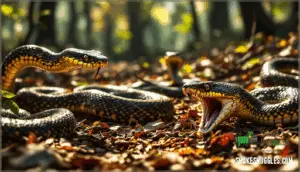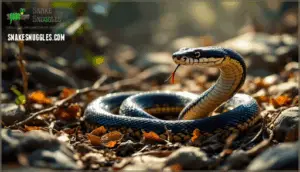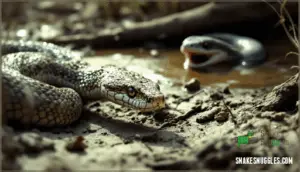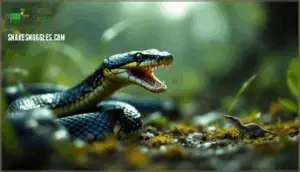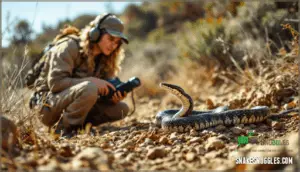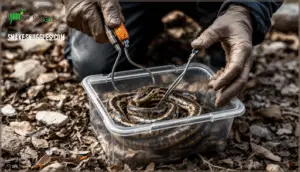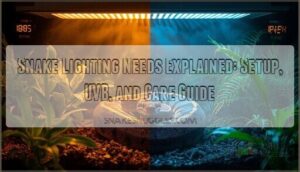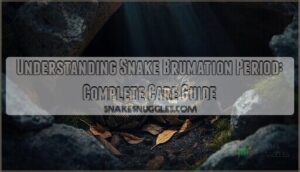This site is supported by our readers. We may earn a commission, at no cost to you, if you purchase through links.
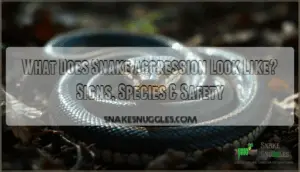
Most people mistake defensive posturing for unprovoked aggression, but snakes telegraph their intentions through precise physical cues: flattened bodies that stretch to intimidating widths, S-shaped coils that load like springs, and vibrating tails that mimic rattlesnakes.
Understanding these signals separates dangerous encounters from manageable ones. Recognition means the difference between safe retreat and a defensive bite that could have been avoided.
Table Of Contents
Key Takeaways
- Snake aggression is actually defensive behavior that follows predictable physical signals like S-shaped coiling, body flattening, hissing, and mouth gaping—most displays are warnings designed to avoid conflict rather than unprovoked attacks.
- Temperature directly controls aggression levels, with snakes showing peak defensive activity between 25–30°C and snakebite rates increasing roughly 6% per 1°C rise in daily temperature.
- Defensive strikes differ from predatory strikes in distance, speed, and venom delivery—defensive bites launch from up to 60 cm away with minimal venom injection, while predatory strikes occur within 3-20 cm and involve precise targeting.
- Recognizing species-specific patterns matters because aggressive snakes like black mambas can deliver 12 rapid bites covering 1.7 meters in 0.3 seconds, while most threatened snakes use bluff displays without ever striking.
What Does Snake Aggression Look Like?
Snake aggression isn’t always what you’d expect. Many people mistake a snake’s defensive reaction for an unprovoked attack, but the body language tells a different story.
Here’s what to watch for when you’re trying to read a snake’s intentions.
Common Behavioral Signs of Aggression
When you spot aggressive behavior in snakes, you’ll notice specific patterns that signal danger. Recognizing these defensive behaviors helps you stay safe during encounters. Here’s what to watch for:
- Auditory warnings like hissing or rattling—rattlesnakes produce up to 90 rattles per second before striking
- Posturing cues including body inflation and rearing to appear larger and more threatening
- Body orientation changes, especially S-shaped coiling that indicates readiness to strike
- Defensive secretions such as cloacal musk release when the snake feels cornered
- Strike dynamics ranging from false lunges without contact to actual defensive bites
These aggressive behaviors differ from normal snake behavior. Most defensive actions act as warnings rather than attacks. Snakes using a hooding threat posture can evoke more fear. Studies show only 3.9% of threatened pygmy rattlesnakes actually struck and fled, meaning most displays are bluffs designed to avoid conflict.
Physical Posturing and Body Language
Beyond these behavioral warnings, you’ll see clear physical signals when a snake feels threatened. A striking coil or S-curve posture appears in nearly all cottonmouths before aggressive displays. You might also notice mouth gaping—an open mouth threat that exposes white tissue inside. Tail vibration and tail waving accompany these defensive behaviours in about 58% of encounters.
Body flattening makes the snake look bigger, sometimes expanding to 1.5 times its normal width. Head elevation and head bobbing help the snake track your position. These aggressive behaviours work together as a warning system before any strike occurs.
Some species, like the Crotalus ravus, display a higher frequency of biting, suggesting heightened defensive behavior.
Distinguishing Aggression From Defensive Behavior
You can tell intent vs. defense apart by watching what happens first. Defensive actions include retreat attempts, warning postures, and mouth gaping before a strike. True aggressive actions skip these signals and involve direct, unsolicited attacks.
Environmental stressors raise defensive bite rates, especially when you enter a snake’s immediate space. Up to 80% of misinterpreted actions labeled "aggressive" are actually defensive reflexes. Accurate classification of snake action and aggression helps you understand reptile defensive actions and reduces unnecessary conflict.
Most snake aggression is defensive—up to 80% of threatening behaviors are protective reflexes, not attacks
Key Aggressive Snake Species and Traits
Not all snakes react the same way when threatened. Some species have earned reputations for their quick tempers and willingness to strike.
Let’s look at which snakes show the most aggression and what makes them dangerous.
Notorious Aggressive Snakes Worldwide
You encounter aggressive snakes across every continent except Antarctica, and some species have earned their fearsome reputations through repeated defensive encounters. The most dangerous snakes combine territorial tendencies with potent venom and proximity to human populations.
- Black Mamba (Dendroaspis polylepis): Strikes repeatedly when cornered, delivering 100–400 mg of neurotoxic venom capable of causing death within 30 minutes
- Eastern Brown Snake (Pseudonaja textilis): Responsible for over 60% of Australia’s snakebite deaths, displaying aggressive S-shaped posturing and short pursuit tendencies
- Saw-Scaled Viper (Echis carinatus): Causes up to 20,000 fatalities annually in India, exhibiting extreme viper hostility in populated areas
Coastal taipans and bushmasters round out the world’s most aggressive snake species.
Venom Potency and Aggressive Tendencies
Venom potency doesn’t always predict aggressive tendencies in venomous snakes. The inland taipan holds the lowest LD50 value at 0.025 mg/kg, making it the deadliest snake by venom efficiency, yet it rarely encounters humans. Aggressive snakes like the eastern brown snake combine moderate potency with territorial strike tendencies.
Diet influences venom composition—species targeting fast-moving prey develop neurotoxin-rich venoms, while defensive aggression correlates with higher protease activity. This evolutionary context shows that survival pressure shapes both potency and aggression independently.
Species-Specific Attack Patterns
Attack patterns split between ambush predators and active pursuers. Death adders wait motionless for 72 hours before striking at 2.5 meters per second. King cobras chase prey at 10 mph and target other snakes in 79% of predation events.
Black mambas deliver up to 12 defensive bites in rapid succession, covering 1.7 meters in 0.3 seconds. These deadly snakes adjust their strategies based on prey selection and environmental triggers.
Environmental and Situational Triggers
Snake aggression doesn’t happen in a vacuum. Temperature shifts, habitat features, and close encounters with humans all play a role in triggering defensive or hostile actions.
Understanding these environmental and situational factors helps you predict when a snake is most likely to strike.
Impact of Temperature and Season
Temperature acts like a dial on snake aggression. Thermal thresholds between 25–30°C trigger peak defensive activity because metabolic rates rise and neuromuscular responses sharpen. You’ll see seasonal aggression climb in spring and fall when snakes emerge or enter brumation. Climate effects drive encounter rates—snakebite odds jump roughly 6% per 1°C increase in daily maximum temperature. Breeding season amplifies territorial displays in males, while stress response hormones like corticosterone surge above 35°C, intensifying reptile actions.
Key temperature-driven patterns you should know:
- Spring and fall peaks: Moderate warmth boosts aggression as snakes shift between activity cycles
- Summer plateau: Overheating above 32°C reduces movement and aggressive displays
- Warm-weather bites: Snakebite incidents rise 5.6% per degree, with shift months seeing 5–7% higher venomous encounters
- Climate change risk: Each 1°C global rise may extend aggressive activity windows by 2–3 months annually
Understanding these snake aggression causes helps you predict risky encounters before they happen.
Habitat Influence on Aggression
Habitat complexity shapes snake aggression like a chessboard shapes strategy. Forest habitats with dense vegetation host more venomous species, raising resource competition and aggressive displacement among cohabitants. When you modify snake habitats—converting forests to crops or buildings—species sensitivity spikes and territorial fights intensify.
In wetlands versus savannahs, snake environment differences alter assemblage structure, triggering new aggression patterns. Species with narrow ranges show heightened snake actions and aggression when habitat shrinks.
Aquatic snakes face intensified territorial conflicts under human modification, while patchy prey distribution in simplified snake habitats escalates interspecific battles for survival resources.
Human Interaction and Aggressive Responses
You can set off a snake faster than you realize. About 50% of venomous bites in the U.S. happen on hands and arms, signaling direct provocation factors. Understanding snake actions reveals that interacting with aggressive snakes requires recognizing aggressive actions before contact.
Urban encounters and rural risks differ—cities stress snakes with frequent disturbance while farms offer rodent prey that draws aggressive species. Mitigation strategies include predictable movement patterns and coexistence tactics like environmental cooling to reduce strike readiness.
Recognizing Aggressive Behavior During Encounters
When you encounter a snake in the wild, knowing what to look for can make all the difference. The way a snake arranges its body and reacts to your presence tells you whether it feels threatened or ready to strike.
Let’s break down the specific signals that indicate a snake is shifting from wary to aggressive.
Threat Displays and Warning Signals
You’ll know a snake feels threatened when it shifts from silent stillness to active warning. Rattlesnakes increase their rattling frequency to approximately 40 Hz, then abruptly jump to 60-100 Hz when you get too close. Cobras rise up to 22% of their body length while hooding and performing sham strikes. These auditory warning signals and visual components carry physiological costs but effectively communicate danger.
Species actions vary widely—cottonmouths gape their white mouths while some snakes flatten their bodies or display tail waving and tail flicking as antipredatory actions.
Defensive Bites Versus Predatory Strikes
When threats escalate past warnings, you’ll see the difference in strike mechanics. Defensive strikes are your wake-up call—they launch from distances up to 60 cm with higher velocity parameters than predatory attacks. Speed matters here, not precision. Predatory strikes focus on targeting differences: accurate jaw placement on small prey from just 3-20 cm away.
Understanding these evolutionary purpose distinctions helps you read snake actions and aggression:
- Distance tells the story: Defensive bites start from twice the range of feeding strikes
- Contact time differs: Aggressive snakes retract fast after defensive hits; predatory strikes involve grasping or envenomation
- Venom delivery varies: Many defensive snake bites inject minimal venom or stay dry—deterrence beats killing
- Post-strike shifts: Feeding follows predation; escape follows defense
Approaching aggressive snakes requires recognizing these snake aggression causes before contact occurs.
Aggression Assessment in The Field
You can measure aggression directly in the field using standard behavioral sequences and field methodologies. Researchers approach snakes to trigger response patterns—rattling, freezing, escape, or biting. In human approach trials, 71% of rattlesnakes bit when pursued, but only 33% bit without warning first. Temperature affects aggression triggers slightly, though males and females show no difference. Recording tools and data reliability protocols like videography and infrared thermometry guarantee accurate quantitative assessment of snake actions and aggression across different snake habitats and distribution zones.
| Method | Bite Response Rate | Warning Signal Rate |
|---|---|---|
| Human Approach | 71% | 67% |
| Aerial Predator | 29% | 100% |
| Terrestrial Predator | 29% | 100% |
Safe Handling and Prevention Strategies
Understanding how to approach aggressive snakes safely can prevent injuries and keep both you and the snake secure.
The right tools and techniques make a real difference when you’re working with defensive species. Here’s what you need to know to stay safe and reduce the risk of bites.
Tools for Managing Aggressive Snakes
When managing aggressive snakes, you’ll need specialized tools for your safety and theirs. Snake hooks maintain a safe distance during approach—24 to 60 inches is standard. Tongs alternatives give a secure grip for larger snakes but require padded edges to prevent injury. Glove limitations are real; they won’t stop venomous bites.
Tube benefits include safe restraint during exams, reducing strikes by 80%. Bag transport with double-stitched seams keeps everyone protected during relocation.
Reducing Aggression in Captive Environments
Beyond the right tools, creating a safe snake environment starts with enrichment strategies and proper habitat design. Enriched enclosures reduce aggression-related actions by 35%. Provide hiding spots and natural substrates to lower defensive displays by 40%.
Maintain species-specific temperatures around 28–32°C to prevent stress-induced aggression. Behavioral conditioning through gentle 10–15 minute interaction reduces strikes within two weeks.
Use feeding practices like separate feeding enclosures to prevent conditioned aggression by 70%. Stress monitoring through body language observation helps identify triggers early, improving snake husbandry and long-term welfare.
Best Practices for Avoiding Snake Attacks
When traveling through snake territory, you need habitat awareness to spot risks before they escalate. Stick to cleared trails and move slowly to avoid surprising a venomous snake. If bitten, immobilize the limb and seek antivenom treatment immediately.
Wear protective gear like thick boots and long pants—they block 80% of strikes. Keep emergency kits with you and know snake bite symptoms. Professional training in control methods improves your response by 60–70%, giving you confidence when trail etiquette and caution aren’t enough.
Frequently Asked Questions (FAQs)
How do juvenile snakes differ in aggression?
Smaller snakes bite more often than adults when threatened. Juveniles rely on defensive bites because they can’t escape as easily.
Their newborn venom is sometimes more lethal as an adaptive defense against predators.
Can aggressive snakes be trained to calm down?
You can’t truly train snakes to suppress aggression. Captivity effects may reduce stress, and consistent interaction can lower defensive responses, but temperament inheritance and natural conduct patterns remain. Domestication potential in snakes is extremely limited compared to mammals.
What sounds indicate an aggressive snake nearby?
You’ll hear hissing sounds and rattling noises from aggressive snakes nearby. These defensive vocalizations serve as threat calls warning you to back off.
Some species produce audible striking sounds when they lunge, combining these snake defensive mechanisms with aggressive behaviours to signal danger.
Do venomous snakes show more aggression than non-venomous?
It’s not all venom and fury. Venomous snakes don’t necessarily show more aggression than non-venomous species.
Snake temperament varies by individual and species, not venom presence.
Defensive actions depend on situation and environment, not bite severity potential.
How does feeding schedule affect snake aggression?
Feeding schedules directly influence food motivation and feeding response in captive snakes. Hungry snakes often display cage aggression when approached, mistaking hands for prey.
Regular feeding frequency and appropriate prey size reduce interaction response intensity and stress-related poor husbandry issues.
Conclusion
Can you truly gauge danger if you misread the signs? Understanding what does snake aggression look like transforms fear into informed caution. The flattened hood, coiled body, and hissing breath aren’t random acts—they’re survival signals meant to protect, not provoke.
When you respect these boundaries and recognize species-specific patterns, encounters shift from panic to preparation. Distance, awareness, and stillness become your best defenses. Read the language snakes speak, and you’ll rarely need to test their bite.
- https://pmc.ncbi.nlm.nih.gov/articles/PMC11978939/
- https://ufwildlife.ifas.ufl.edu/pdfs/Cottonmouth%20attack.pdf
- https://journals.biologists.com/bio/article/14/4/bio061791/367576/Unpredictable-aggressive-defence-of-the-venomous
- https://www.sciencedirect.com/science/article/abs/pii/S0016648016303641
- https://journals.plos.org/plosntds/article?id=10.1371%2Fjournal.pntd.0009047

